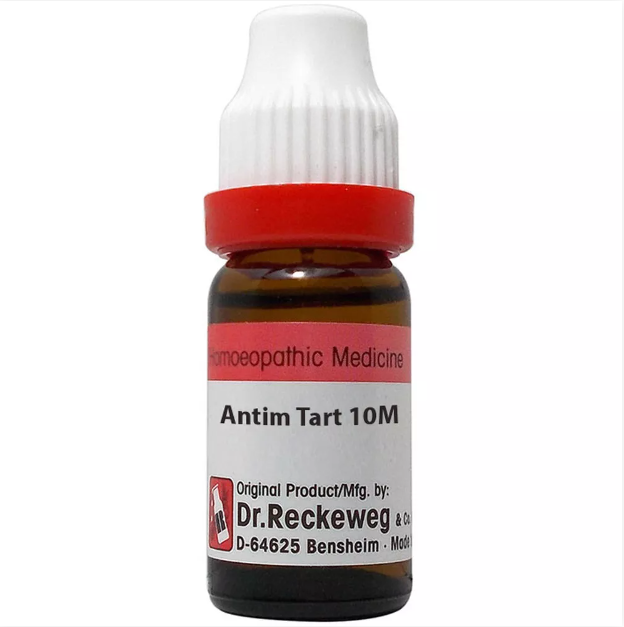ANTIMONIUM TARTARICUM 6C, 12C, 30C, 200C, 1M, 10M USES AND SYMPTOM
ANTIMONIUM TARTARICUM
(Tartar Emetic, Antimony-Potash Tartrate)
 While sharing some symptoms with Antimonium crudum, Ant-tart has distinct characteristics. Its primary clinical use focuses on respiratory ailments, especially when there’s rattling of mucus with minimal expectoration. Key features include drowsiness, weakness, and sweating. It’s beneficial for gastric issues in drinkers and gout sufferers, as well as conditions like cholera morbus and bilharziasis. Ant-tart addresses dysuria, burning in the bladder and urethra, rectal burning, and bloody mucus in stools. It indirectly affects parasites by enhancing the body’s oxidizing processes. Side effects may include chills, muscle pain, tremors, and profound weakness.
While sharing some symptoms with Antimonium crudum, Ant-tart has distinct characteristics. Its primary clinical use focuses on respiratory ailments, especially when there’s rattling of mucus with minimal expectoration. Key features include drowsiness, weakness, and sweating. It’s beneficial for gastric issues in drinkers and gout sufferers, as well as conditions like cholera morbus and bilharziasis. Ant-tart addresses dysuria, burning in the bladder and urethra, rectal burning, and bloody mucus in stools. It indirectly affects parasites by enhancing the body’s oxidizing processes. Side effects may include chills, muscle pain, tremors, and profound weakness.
Mind: Notable symptoms include deep despondency, fear of solitude, muttering delirium, and stupor. Children may whimper when touched.
Head: Vertigo alternating with drowsiness, with a band-like sensation across the forehead. Headaches feel like pressure from a band (similar to Nitric acid).
Face: Cold, pale, and sweaty, with incessant quivering of the chin and lower jaw. Mouth: Tongue coated white, red edges, or dry and brown. Difficulty swallowing liquids, vomiting in any position except right-side lying, nausea after eating with faintness, and thirst for cold water or acidic fruits.
Abdomen: Spasmodic colic, flatulence, pressure on bending forward, and diarrhea in eruptive diseases.
Urinary: Burning during and after urination, bloody urine with bladder pain, frequent urges, bladder and urethra catarrh, and orchitis.
Respiratory: Hoarseness, excessive mucus with minimal expectoration, burning sensation ascending from chest to throat, rapid, difficult breathing, coughing after eating, and bronchial congestion.
Back: Severe pain in the lower back, movement-induced nausea and sweating, and a sensation of heaviness on the coccyx.
Sleep: Profound drowsiness, electric-like shocks on falling asleep, and an irresistible urge to sleep.
Fever: Coldness, trembling, intense heat, copious sweating, and lethargy during intermittent fever. Skin: Pustular eruptions leaving bluish-red marks, and warts.
Modalities: Aggravated in the evening, lying down at night, warmth, damp cold weather, and sour foods; improved by sitting upright, belching, and expectoration.
Relationship: Antidotes: Pulsatilla, Sepia.
Comparison: Kali sulphuricum, Ipecacuanha.
Dosage: Second and sixth triturations are recommended; lower potencies may sometimes worsen symptoms.
SYMPTOMS OF ANTIMONIUM TARTARICUM
- Respiratory symptoms: rattling of mucus with little expectoration, hoarseness, difficulty breathing, coughing after eating, and bronchial congestion.
- Gastric issues: difficulty swallowing liquids, vomiting, nausea after eating, and thirst for cold water or acidic fruits.
- Urinary symptoms: burning during and after urination, bloody urine with bladder pain, frequent urges, bladder and urethra catarrh, and orchitis.
- Skin symptoms: pustular eruptions leaving bluish-red marks, and warts.
- Mental and emotional symptoms: deep despondency, fear of solitude, muttering delirium, and stupor.
- Physical symptoms: weakness, sweating, quivering of the chin and lower jaw, headache with band-like sensation, and severe pain in the lower back with movement-induced nausea and sweating.
selection of the potency
Individualization:
- Homeopathy is based on the principle of treating the individual, not just the disease. The unique symptoms and characteristics of the person are crucial in determining the most suitable potency.
Intensity of Symptoms:
- The intensity of the symptoms guides the choice of potency. If the symptoms are intense and acute, a lower potency (e.g., 6C, 30C) might be considered. For chronic conditions with less intensity, higher potencies (e.g., 200C, 1M) may be appropriate.
Sensitivity of the Patient:
- Some individuals are more sensitive to homeopathic remedies, while others may require higher potencies. The practitioner considers the patient’s sensitivity when selecting the potency.
Acute vs. Chronic Conditions:
- Lower potencies are often used for acute conditions, while higher potencies may be considered for chronic or long-standing issues.
Previous Response to Potencies:
- The patient’s response to previous homeopathic treatments helps guide the choice of potency. If a particular potency has been effective in the past, it may be repeated or adjusted as needed.
Vital Force and Susceptibility:
- Homeopathy views illness as a disturbance in the vital force. The practitioner assesses the patient’s overall vitality and susceptibility to determine the appropriate potency.
Aggravation or Amelioration:
- The direction of the symptom response (aggravation or amelioration) after taking a remedy can influence the choice of potency.
Miasmatic Considerations:
- In classical homeopathy, the concept of miasms (inherited disease tendencies) is considered. The practitioner take this into account when selecting the potency.
Practitioner Experience:
- The experience and preference of the homeopathic practitioner play a role. Some practitioners may have success with certain potencies based on their clinical experience.
SAFETY INFORMATION
- Do not exceed the recommended dose by physician
- Keep out of the reach of children
- Store in a cool dry place away from direct sunlight
- Maintain half an hour gap between food/drink/any other medicines and homoeopathic medicine
- Avoid any strong smell in the mouth while taking medicine e.g. camphor, garlic, onion, coffee, hing
Medicine images use for reference only selection of homeopathic medicine depends on the individual’s specific symptoms and overall constitution. Moreover, homeopathy is a holistic system of medicine that treats the individual as a whole. In addition to addressing the physical symptoms, it takes into account the emotional and mental state of the person. Consequently, it’s crucial to consult with a qualified homeopathic practitioner for personalized treatment.
The information provided on this website is intended solely for educational purposes. Always seek the advice of your physician or other qualified health provider.
